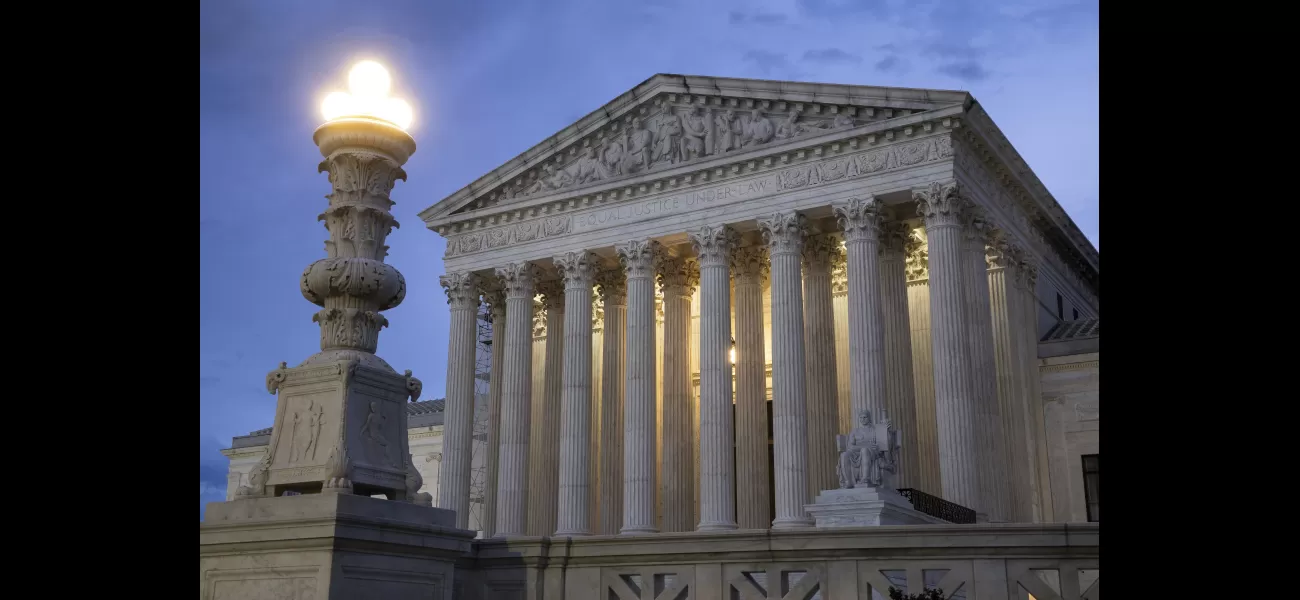The Supreme Court is not immune to bias, which can have damaging effects.
Justices' arrogance, not politics, is why they're unpopular.
August 30th 2023.

The Supreme Court's public approval has recently hit record lows, and many have attributed this to its increasing partisanship. It is certainly true that the court has moved rightward on a number of important issues, from abortion to guns to voting rights to environmental law. But is partisanship the only explanation?
The biggest problem with this diagnosis is that the Supreme Court has always been a part of politics, not above it. Even John Marshall, the most important chief justice in our history, was a Federalist party operative appointed by President John Adams to thwart the incoming Jefferson administration. Yet throughout this period, the court’s public stature actually increased. The same could be said of the New Deal Court, which was appointed by President Franklin D. Roosevelt and consistently voted to uphold the New Deal legislation. This suggests that partisanship alone is not enough to cause the public to lose faith in the Court.
What is really different and dangerous about today’s justices is not partisanship, but rather a cognitive trap known as overconfidence bias. Today’s justices possess a frightening degree of certainty that they can alone answer society’s most pressing problems with just the right lawyerly argument. This certitude developed from a noble place, when the court needed to declare the law’s true meaning and override racially discriminatory laws. But this power has become seductive, and the court is now prone to overreach in areas such as guns, abortion, religion, and the death penalty.
Evidence of this overconfidence is everywhere. The court now invalidates an average of more than three federal laws per year, compared to less than one per year between 1788 and 1994. Furthermore, the justices’ personalities are often marked by an inability to acknowledge doubt. And this is also visible in their opinions. In overturning the right to abortion, for example, Justice Samuel Alito's opinion declared that the legal reasoning of respected jurists was “far outside the bounds of any reasonable interpretation” despite being riddled with historical inaccuracies. Similarly, in Kennedy v. Louisiana the court struck down the death penalty for cases of aggravated child rape without the Constitution being clear on the matter.
A humble court would recognize the limits of its own judgment and act more cautiously. But this is not the court we have, and the public is starting to take notice.
The Supreme Court's public approval has been dropping to record lows, and the most common explanation is that partisanship is to blame. This might be an understandable explanation, as the court has certainly been partisan in many of its rulings, from abortion to guns and voting rights to environmental law.
However, this explanation is too simplistic. The Supreme Court has always been part of the political landscape, not above it. Chief Justice John Marshall, often considered the most important Chief Justice in our history, was a Federalist Party operative appointed by President John Adams to counter the incoming Jefferson administration. Marshall delivered on this promise, issuing pro-Federalist rulings for three decades. Despite this, the court's public stature only increased during this time.
Similarly, when President Franklin D. Roosevelt appointed eight justices to the court between 1937 and 1943, it consistently voted to uphold the New Deal legislation that he had campaigned on. The public approval for the court did not diminish, but rather increased.
These historical periods suggest that partisanship alone is not enough to cause a decrease in public legitimacy. The real problem is something else: overconfidence. Nobel Prize-winning psychologist Daniel Kahneman has called this the "most damaging" of all human biases.
Today's justices have a frightening degree of certainty that they alone can answer society's most pressing problems with the right lawyerly argument. This certitude developed from a noble place, in that when the court was faced with legal challenges to racially discriminatory laws in the mid-20th century, the justices needed to be able to proclaim those laws inconsistent with the Constitution's true meaning.
But this power to declare the law's meaning and override democratically enacted policies is seductive. Ideas such as living constitutionalism and originalism were created to justify judicial intervention in cases such as abortion and the death penalty, and this has led to an overconfident Supreme Court.
The evidence of this overconfidence can be seen in the frequency with which the court overrules the judgment of elected lawmakers, and in the justices' personalities. In Supreme Hubris, a book that shares stories of the justices' inability to acknowledge doubt, it is clear that they often express absolute certainty in their views on a wide range of issues.
The overconfidence problem is also reflected in the court's opinions. In overturning the right to abortion, Justice Alito's opinion declared that the legal reasoning of respected jurists was "far outside the bounds of any reasonable interpretation," even though the "most important historical fact" on which he based his conclusion was riddled with inaccuracies.
The same goes for opinions that reach liberal results. In Kennedy v. Louisiana, the court struck down the death penalty for cases of aggravated child rape, even though the Constitution was far from clear on the matter and elected officials had differing views.
What a humble court would do is recognize the limits of its own judgment and act more cautiously as a result. Unfortunately, that is not the court we have today. We have a court that is overconfident in its own abilities, and this is what is truly dangerous.
The biggest problem with this diagnosis is that the Supreme Court has always been a part of politics, not above it. Even John Marshall, the most important chief justice in our history, was a Federalist party operative appointed by President John Adams to thwart the incoming Jefferson administration. Yet throughout this period, the court’s public stature actually increased. The same could be said of the New Deal Court, which was appointed by President Franklin D. Roosevelt and consistently voted to uphold the New Deal legislation. This suggests that partisanship alone is not enough to cause the public to lose faith in the Court.
What is really different and dangerous about today’s justices is not partisanship, but rather a cognitive trap known as overconfidence bias. Today’s justices possess a frightening degree of certainty that they can alone answer society’s most pressing problems with just the right lawyerly argument. This certitude developed from a noble place, when the court needed to declare the law’s true meaning and override racially discriminatory laws. But this power has become seductive, and the court is now prone to overreach in areas such as guns, abortion, religion, and the death penalty.
Evidence of this overconfidence is everywhere. The court now invalidates an average of more than three federal laws per year, compared to less than one per year between 1788 and 1994. Furthermore, the justices’ personalities are often marked by an inability to acknowledge doubt. And this is also visible in their opinions. In overturning the right to abortion, for example, Justice Samuel Alito's opinion declared that the legal reasoning of respected jurists was “far outside the bounds of any reasonable interpretation” despite being riddled with historical inaccuracies. Similarly, in Kennedy v. Louisiana the court struck down the death penalty for cases of aggravated child rape without the Constitution being clear on the matter.
A humble court would recognize the limits of its own judgment and act more cautiously. But this is not the court we have, and the public is starting to take notice.
The Supreme Court's public approval has been dropping to record lows, and the most common explanation is that partisanship is to blame. This might be an understandable explanation, as the court has certainly been partisan in many of its rulings, from abortion to guns and voting rights to environmental law.
However, this explanation is too simplistic. The Supreme Court has always been part of the political landscape, not above it. Chief Justice John Marshall, often considered the most important Chief Justice in our history, was a Federalist Party operative appointed by President John Adams to counter the incoming Jefferson administration. Marshall delivered on this promise, issuing pro-Federalist rulings for three decades. Despite this, the court's public stature only increased during this time.
Similarly, when President Franklin D. Roosevelt appointed eight justices to the court between 1937 and 1943, it consistently voted to uphold the New Deal legislation that he had campaigned on. The public approval for the court did not diminish, but rather increased.
These historical periods suggest that partisanship alone is not enough to cause a decrease in public legitimacy. The real problem is something else: overconfidence. Nobel Prize-winning psychologist Daniel Kahneman has called this the "most damaging" of all human biases.
Today's justices have a frightening degree of certainty that they alone can answer society's most pressing problems with the right lawyerly argument. This certitude developed from a noble place, in that when the court was faced with legal challenges to racially discriminatory laws in the mid-20th century, the justices needed to be able to proclaim those laws inconsistent with the Constitution's true meaning.
But this power to declare the law's meaning and override democratically enacted policies is seductive. Ideas such as living constitutionalism and originalism were created to justify judicial intervention in cases such as abortion and the death penalty, and this has led to an overconfident Supreme Court.
The evidence of this overconfidence can be seen in the frequency with which the court overrules the judgment of elected lawmakers, and in the justices' personalities. In Supreme Hubris, a book that shares stories of the justices' inability to acknowledge doubt, it is clear that they often express absolute certainty in their views on a wide range of issues.
The overconfidence problem is also reflected in the court's opinions. In overturning the right to abortion, Justice Alito's opinion declared that the legal reasoning of respected jurists was "far outside the bounds of any reasonable interpretation," even though the "most important historical fact" on which he based his conclusion was riddled with inaccuracies.
The same goes for opinions that reach liberal results. In Kennedy v. Louisiana, the court struck down the death penalty for cases of aggravated child rape, even though the Constitution was far from clear on the matter and elected officials had differing views.
What a humble court would do is recognize the limits of its own judgment and act more cautiously as a result. Unfortunately, that is not the court we have today. We have a court that is overconfident in its own abilities, and this is what is truly dangerous.
[This article has been trending online recently and has been generated with AI. Your feed is customized.]
[Generative AI is experimental.]
0
0
Submit Comment





